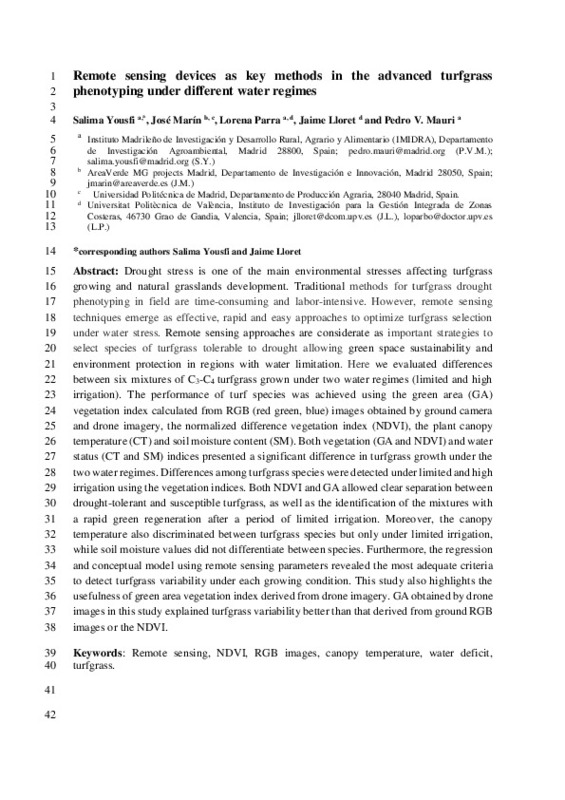JavaScript is disabled for your browser. Some features of this site may not work without it.
Buscar en RiuNet
Listar
Mi cuenta
Estadísticas
Ayuda RiuNet
Admin. UPV
Remote sensing devices as key methods in the advanced turfgrass phenotyping under different water regimes
Mostrar el registro sencillo del ítem
Ficheros en el ítem
| dc.contributor.author | Yousfi, Salima
|
es_ES |
| dc.contributor.author | Marin, José
|
es_ES |
| dc.contributor.author | Parra, Lorena
|
es_ES |
| dc.contributor.author | Lloret, Jaime
|
es_ES |
| dc.contributor.author | Mauri, Pedro V.
|
es_ES |
| dc.date.accessioned | 2023-11-29T19:01:31Z | |
| dc.date.available | 2023-11-29T19:01:31Z | |
| dc.date.issued | 2022-05-31 | es_ES |
| dc.identifier.issn | 0378-3774 | es_ES |
| dc.identifier.uri | http://hdl.handle.net/10251/200349 | |
| dc.description.abstract | [EN] Turfgrass phenotyping is a potential tool in different grass program breeding. The traditional methods for turfgrass drought phenotyping in field are time-consuming and labor-intensive. However, remote sensing techniques emerge as effective, rapid and easy approaches to optimize turfgrass selection under water stress. Remote sensing approaches are considerate as important strategies to select species of turfgrass tolerable to drought allowing green space sustainability and environment protection in regions with water limitation. Here we evaluated differences between six mixtures of C-3-C-4 turfgrass grown under two water regimes (limited and high irrigation). The performance of turf species was achieved using the green area (GA) vegetation index calculated from RGB (red green, blue) images obtained by ground camera and drone imagery, the normalized difference vegetation index (NDVI), the plant canopy temperature (CT) and soil moisture content (SM). Both vegetation (GA and NDVI) and water status (CT and SM) indices presented a significant difference in turfgrass growth under the two water regimes. Differences among turfgrass species were detected under limited and high irrigation using the vegetation indices. Both NDVI and GA allowed clear separation between drought-tolerant and susceptible turf grass, as well as the identification of the mixtures with a rapid green regeneration after a period of limited irrigation. Moreover, the canopy temperature also discriminated between turfgrass species but only under limited irrigation, while soil moisture values did not differentiate between species. Furthermore, the regression and conceptual model using remote sensing parameters revealed the most adequate criteria to detect turfgrass variability under each growing condition. This study also highlights the usefulness of green area vegetation index derived from drone imagery. GA obtained by drone images in this study explained turfgrass variability better than that derived from ground RGB images or the NDVI. | es_ES |
| dc.description.sponsorship | Projects GO-PDR18-XEROCESPED funded by the European Agricultural Fund for Rural Development (EAFRD) and IMIDRA and the AREA VERDE-MG projects are acknowledged. | es_ES |
| dc.language | Inglés | es_ES |
| dc.publisher | Elsevier | es_ES |
| dc.relation.ispartof | Agricultural Water Management | es_ES |
| dc.rights | Reconocimiento - No comercial - Sin obra derivada (by-nc-nd) | es_ES |
| dc.subject | Remote sensing | es_ES |
| dc.subject | NDVI | es_ES |
| dc.subject | RGB images | es_ES |
| dc.subject | Canopy temperature | es_ES |
| dc.subject | Water deficit | es_ES |
| dc.subject | Turfgrass | es_ES |
| dc.subject.classification | INGENIERÍA TELEMÁTICA | es_ES |
| dc.title | Remote sensing devices as key methods in the advanced turfgrass phenotyping under different water regimes | es_ES |
| dc.type | Artículo | es_ES |
| dc.identifier.doi | 10.1016/j.agwat.2022.107581 | es_ES |
| dc.relation.projectID | info:eu-repo/grantAgreement/CAM//PDR18-XEROCESPED/ | es_ES |
| dc.rights.accessRights | Abierto | es_ES |
| dc.contributor.affiliation | Universitat Politècnica de València. Instituto de Investigación para la Gestión Integral de Zonas Costeras - Institut d'Investigació per a la Gestió Integral de Zones Costaneres | es_ES |
| dc.contributor.affiliation | Universitat Politècnica de València. Escuela Politécnica Superior de Gandia - Escola Politècnica Superior de Gandia | es_ES |
| dc.description.bibliographicCitation | Yousfi, S.; Marin, J.; Parra, L.; Lloret, J.; Mauri, PV. (2022). Remote sensing devices as key methods in the advanced turfgrass phenotyping under different water regimes. Agricultural Water Management. 266:1-11. https://doi.org/10.1016/j.agwat.2022.107581 | es_ES |
| dc.description.accrualMethod | S | es_ES |
| dc.relation.publisherversion | https://doi.org/10.1016/j.agwat.2022.107581 | es_ES |
| dc.description.upvformatpinicio | 1 | es_ES |
| dc.description.upvformatpfin | 11 | es_ES |
| dc.type.version | info:eu-repo/semantics/publishedVersion | es_ES |
| dc.description.volume | 266 | es_ES |
| dc.relation.pasarela | S\491772 | es_ES |
| dc.contributor.funder | Comunidad de Madrid | es_ES |
| dc.contributor.funder | European Agricultural Fund for Rural Development | es_ES |







![[Cerrado]](/themes/UPV/images/candado.png)

